
Chinese Journal of Applied Chemistry ›› 2022, Vol. 39 ›› Issue (12): 1842-1853.DOI: 10.19894/j.issn.1000-0518.220078
Previous Articles Next Articles
Dispersion of Carbon Black in Isoprene Rubber and Its Static and Dynamic Properties
Yong-Peng LYU1,2, Yu-Ge WANG1,2, Qian-Qian GU1,2, Zhi-Cai ZHANG1,2, Jian-Shu XIAO1,2, Yuan YIN1, Hong-Guo SUN1, Ya-Fang ZHENG1, Zhao-Yan SUN1,2( )
)
- 1.State Key Laboratory of Polymer Physics and Chemistry,Changchun Institute of Applied Chemistry,Chinese Academy of Sciences,Changchun 130022,China
2.School of Applied Chemistry and Engineering,University of Science and Technology of China,Hefei 230026,China
-
Received:2022-03-17Accepted:2022-08-03Published:2022-12-01Online:2022-12-13 -
Contact:Zhao-Yan SUN -
About author:zysun@ciac.ac.cn
-
Supported by:the National Natural Science Foundation of China(21790344)
CLC Number:
Cite this article
Yong-Peng LYU, Yu-Ge WANG, Qian-Qian GU, Zhi-Cai ZHANG, Jian-Shu XIAO, Yuan YIN, Hong-Guo SUN, Ya-Fang ZHENG, Zhao-Yan SUN. Dispersion of Carbon Black in Isoprene Rubber and Its Static and Dynamic Properties[J]. Chinese Journal of Applied Chemistry, 2022, 39(12): 1842-1853.
share this article
Add to citation manager EndNote|Ris|BibTeX
URL: http://yyhx.ciac.jl.cn/EN/10.19894/j.issn.1000-0518.220078
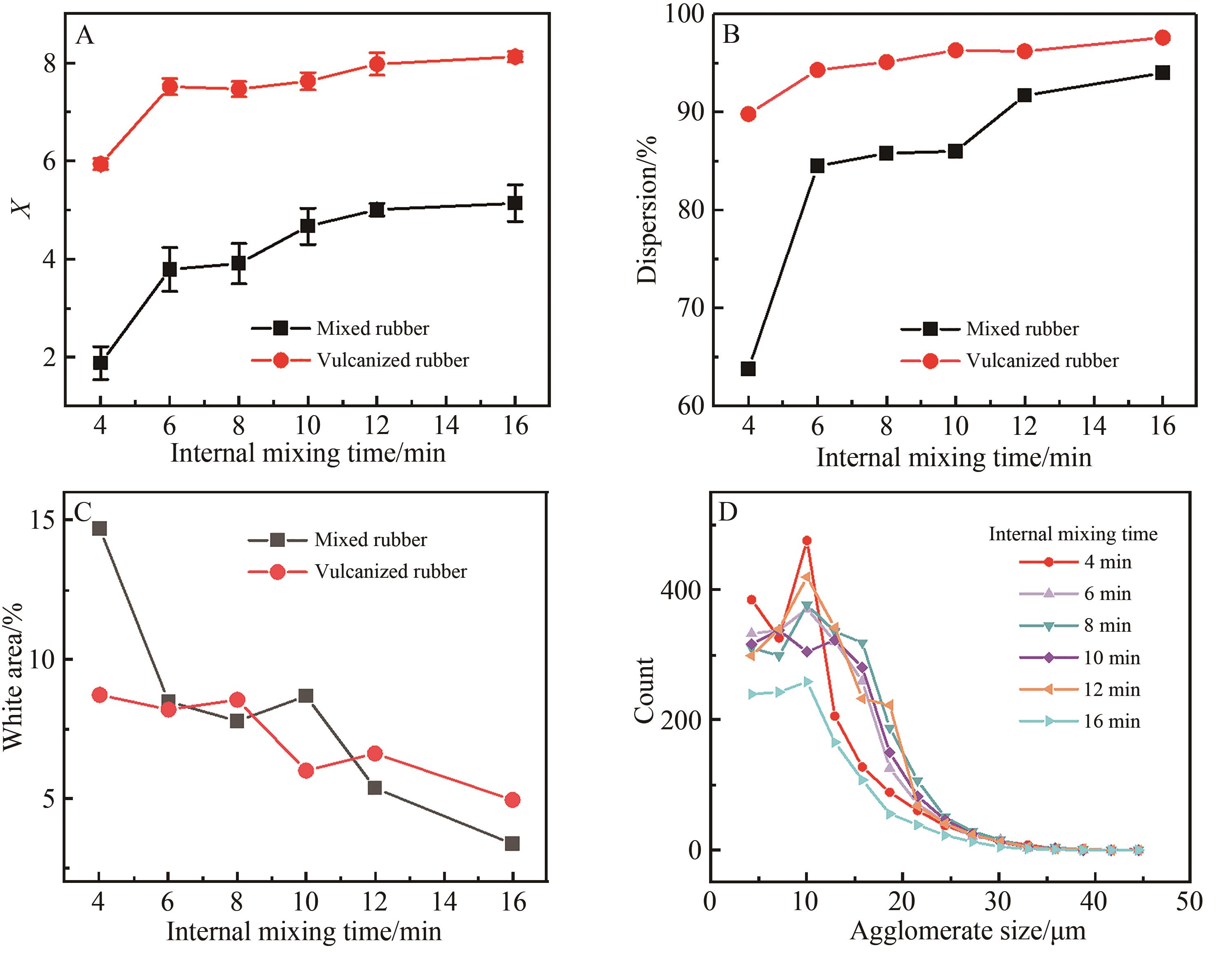
Fig.1 The dispersion grades(A), dispersion percentage(B), white area percentage(C) and agglomerations size distribution(D) of mixed rubber and vulcanized rubber obtained by different internal mixing time
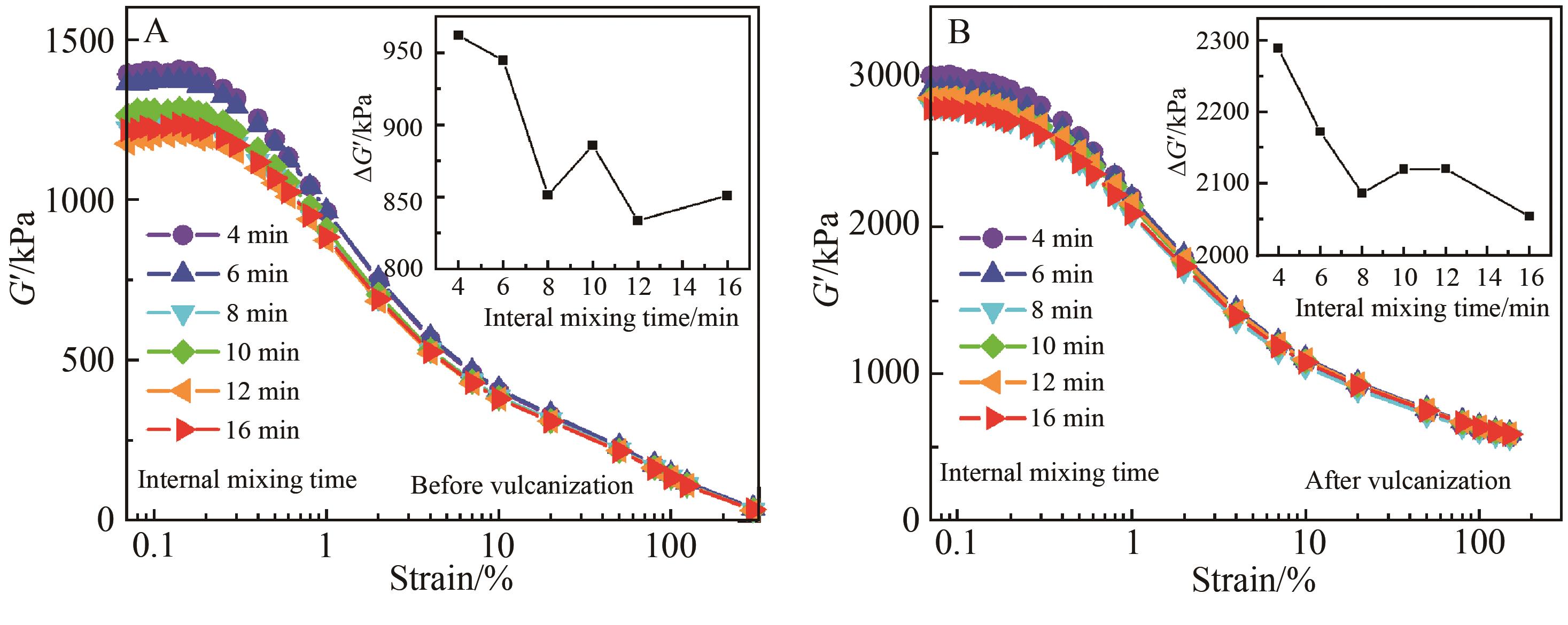
Fig.2 The storage modulus of mixed rubber (A) and vulcanized rubber (B) under different strains. The insets show the storage modulus difference between small strain (~0.1%) and large strain (~50%) of mixed rubber and vulcanized rubber with different internal mixing time, respectively
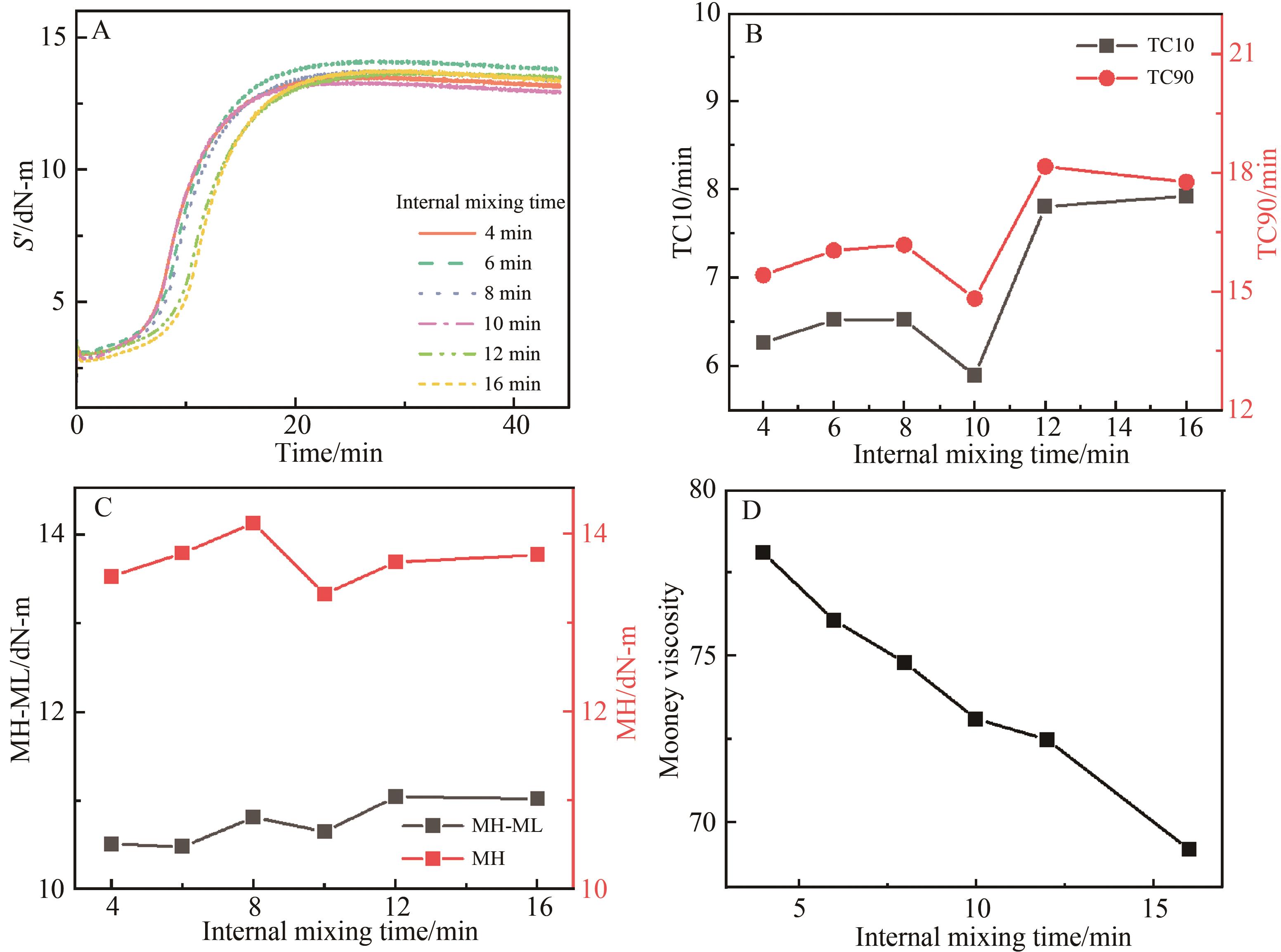
Fig.3 The vulcanization curve (A), the positive vulcanization time and scorch time (B), the maximum torque and the difference between maximum and minimum torque (C) and the Mooney viscosity of rubbers (D) obtained with different internal mixing time
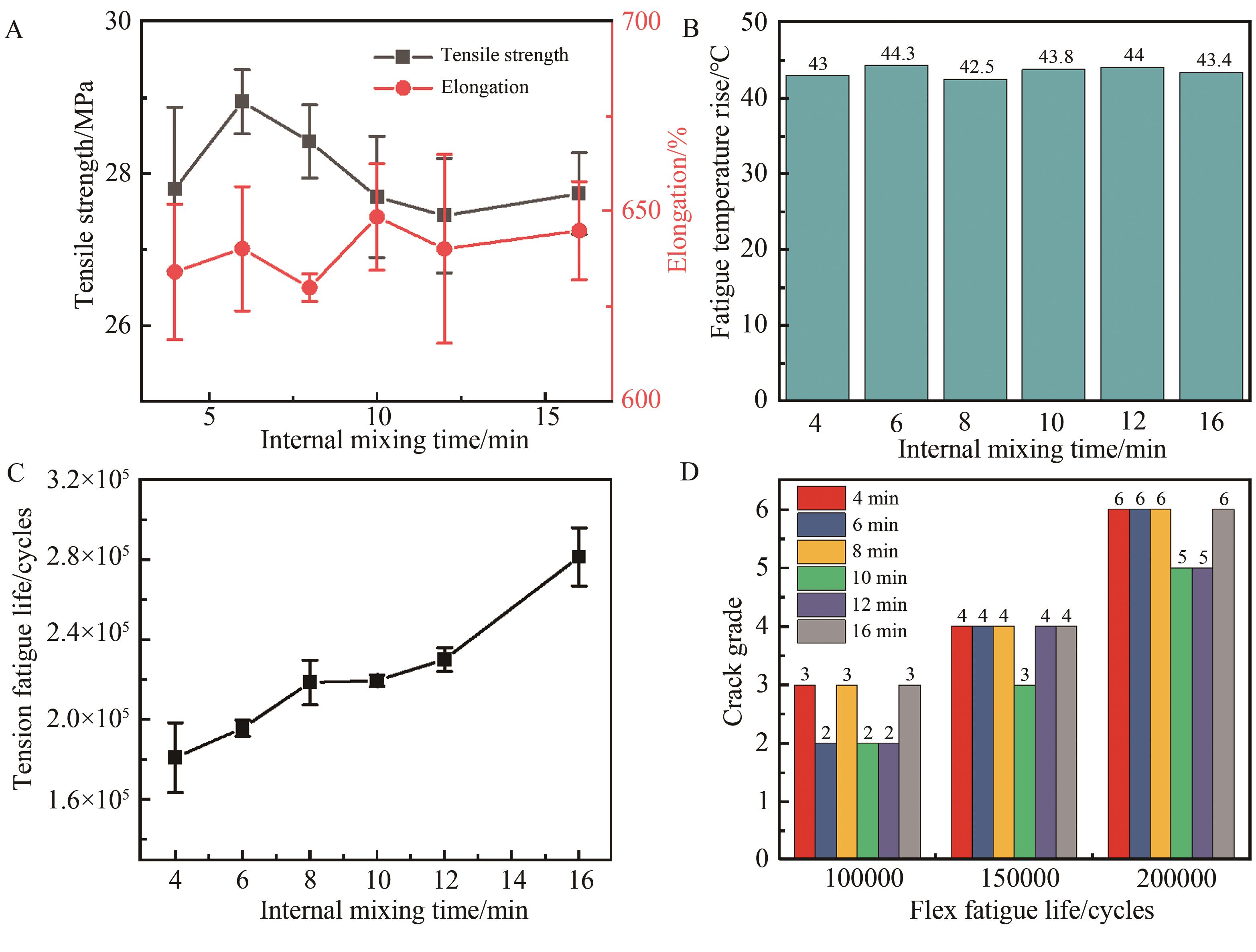
Fig.4 The tensile strength and elongation(A), the fatigue temperature(B), the tensile fatigue life(C) and the cracking grade during flexural fatigue(D) of vulcanized rubber with different internal mixing time
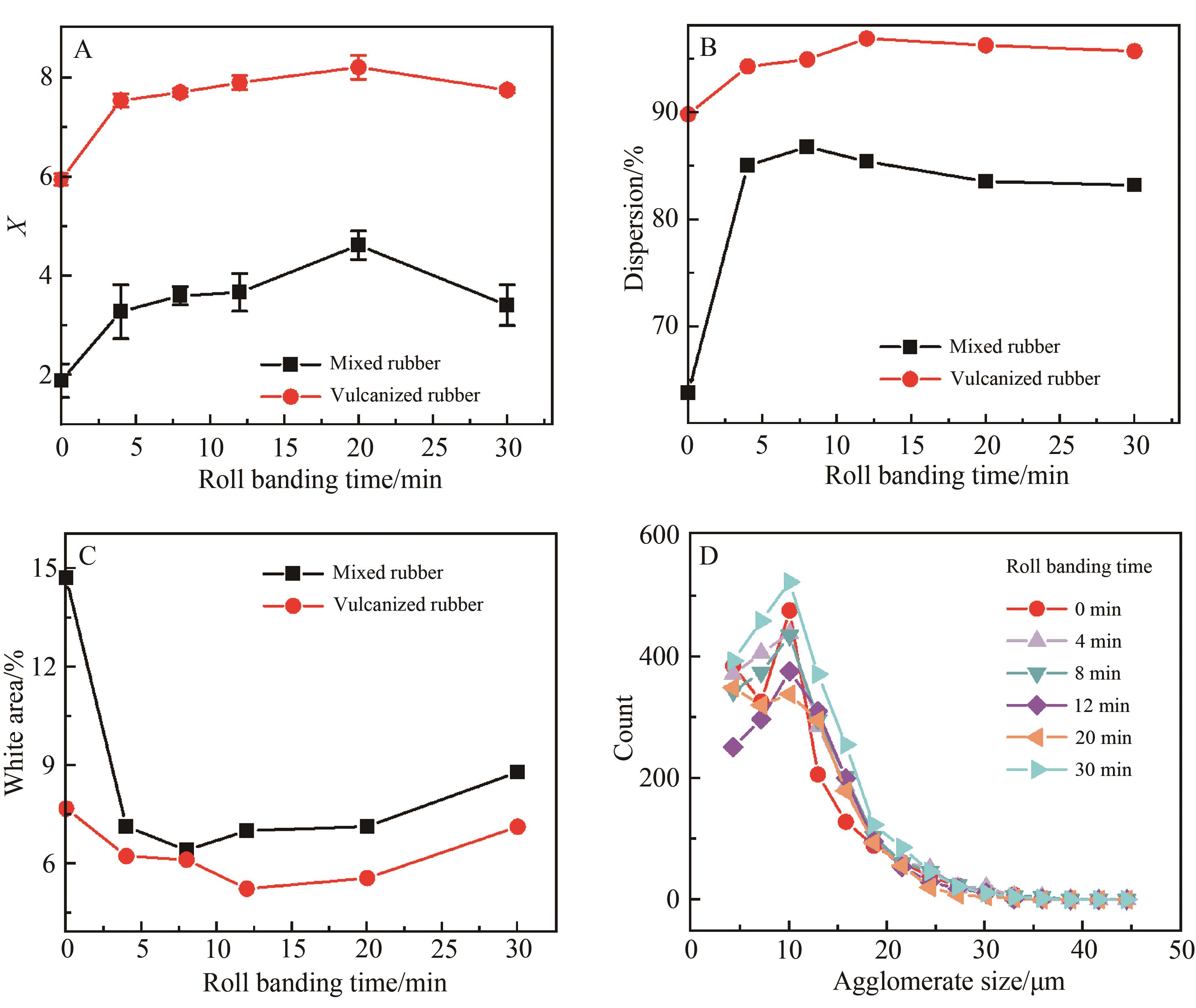
Fig.5 The dispersion grades (A), dispersion percentage (B), white area percentage C) and agglomerations size distribution (D) of mixed rubber and vulcanized rubber obtained by different roll banding time
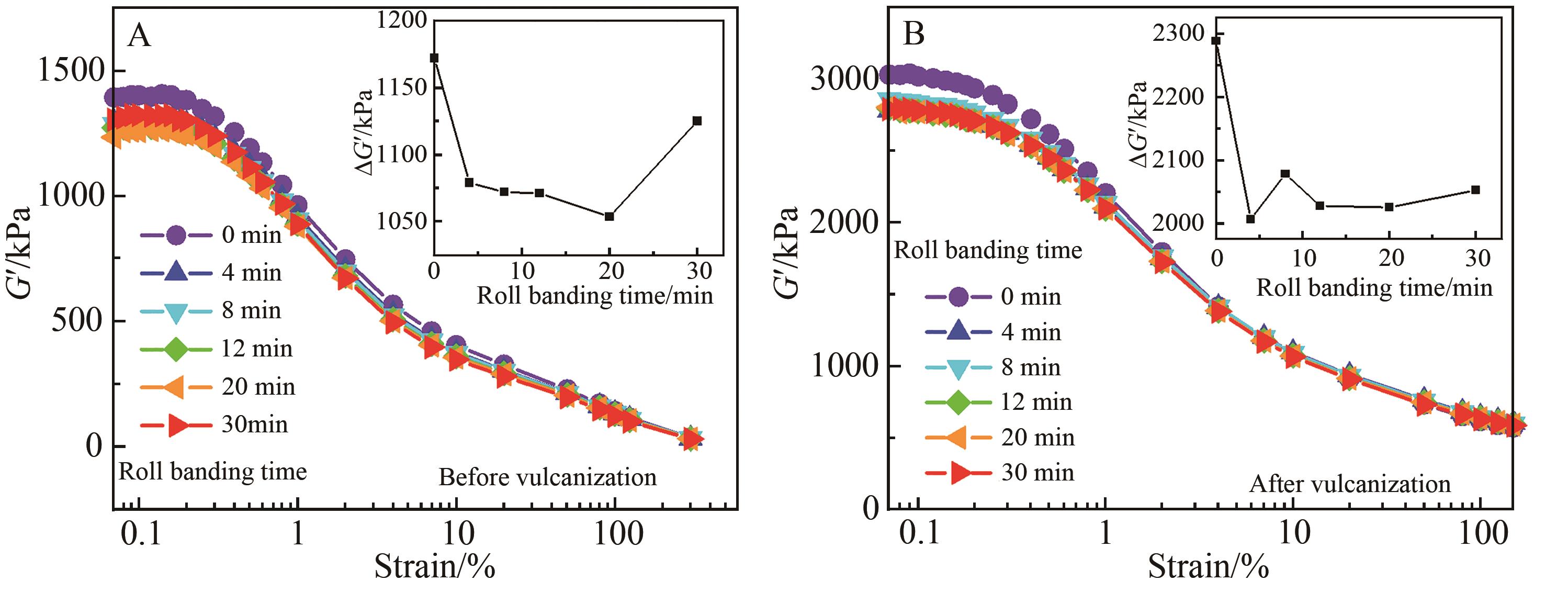
Fig.6 The storage modulus of (A) mixed rubber and (B) vulcanized rubber under different strains. The insets show the storage modulus difference between small strain (~0.1%) and large strain (~50%) of mixed rubber and vulcanized rubber with different roll banding time, respectively

Fig.7 The vulcanization curve(A), the positive vulcanization time and scorch time (B), the maximum torque and the difference between maximum and minimum torque (C) and the Mooney viscosity (D) of rubbers obtained with different roll banding time
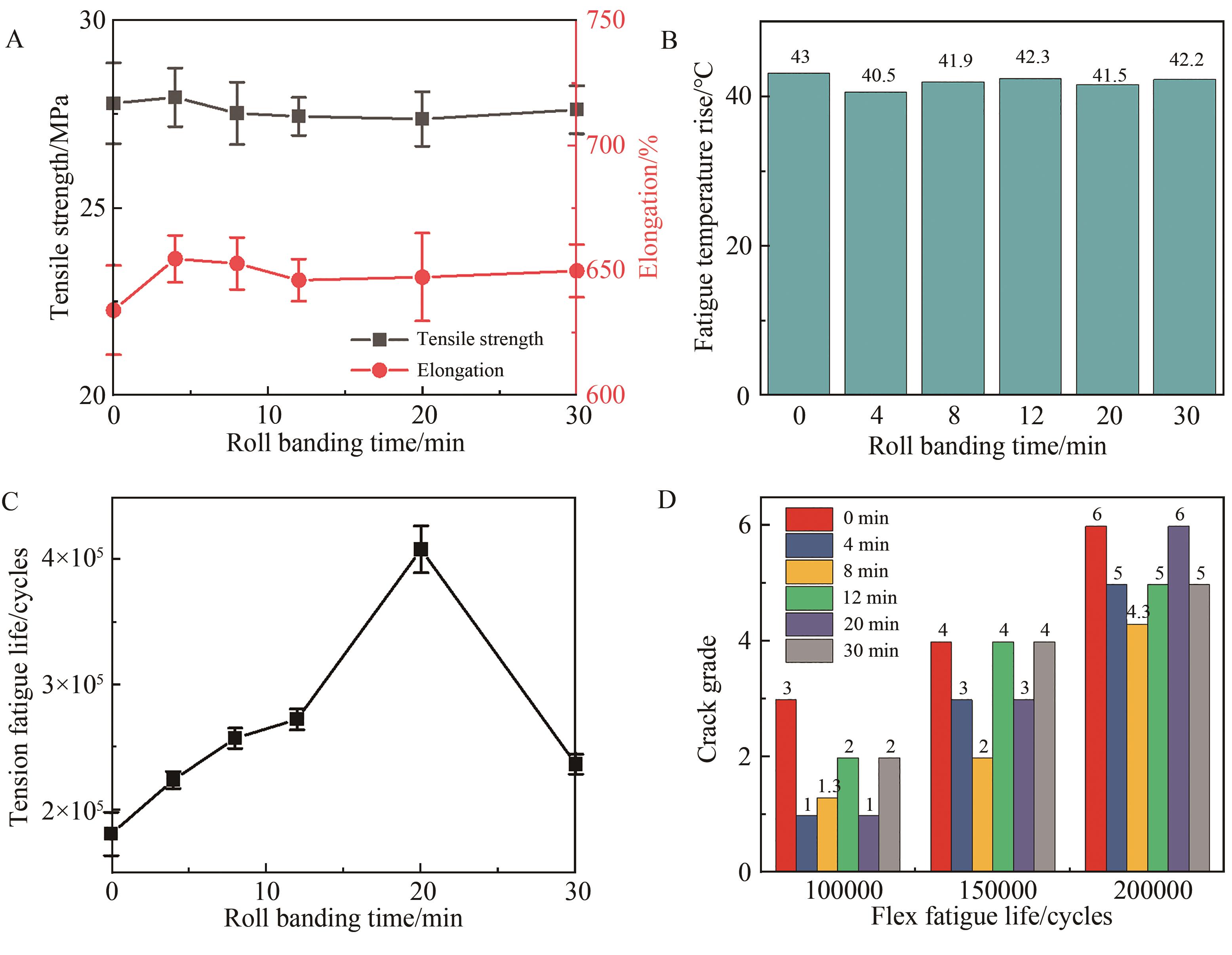
Fig.8 The tensile strength and elongation (A), the fatigue temperature (B), the tensile fatigue life (C) and the cracking grade during flexural fatigue (D) of vulcanized rubber with different roll banding time
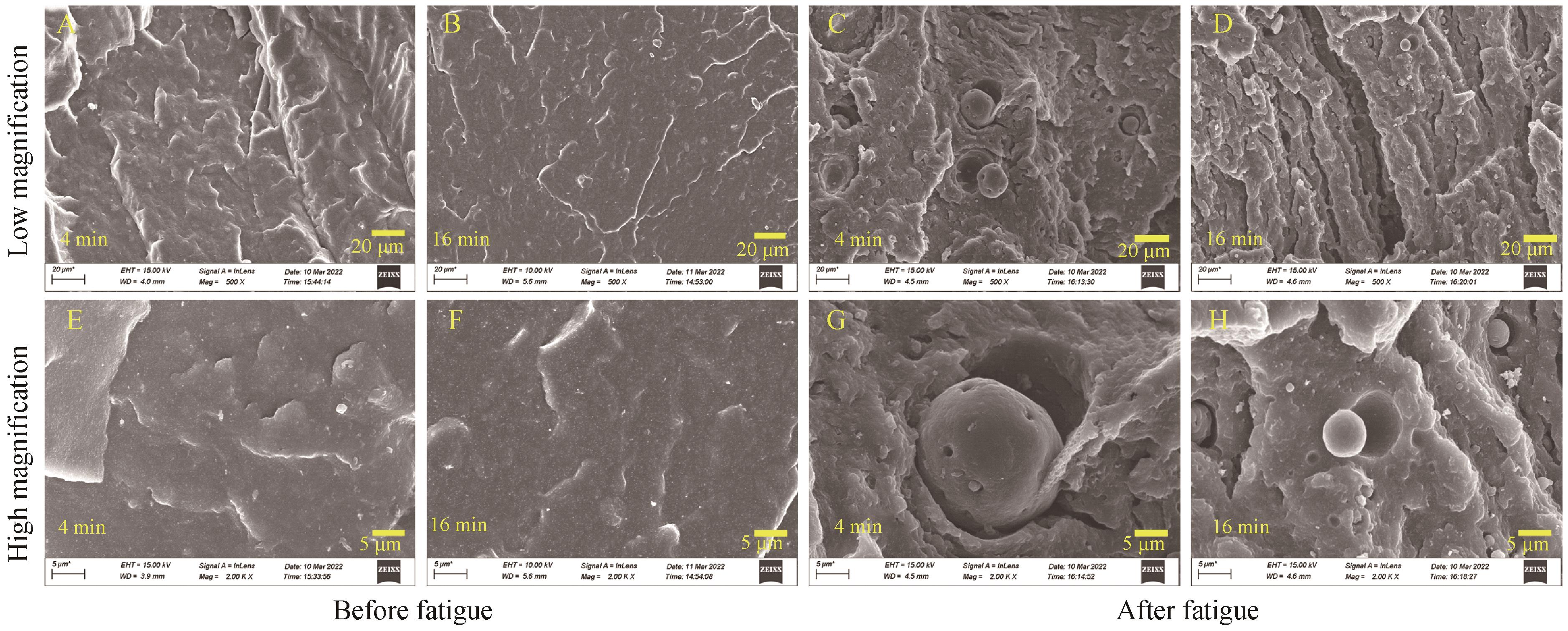
Fig.9 Surface morphology of vulcanized rubber (internal mixing 4 min) before fatigue test with low (A) and high (E) magnification; Surface morphology of vulcanized rubber (internal mixing 16 min) before fatigue test with low (B) and high (F) magnification; Surface morphology of vulcanized rubber (internal mixing 4 min) after fatigue test with low (C) and high (G) magnification; Surface morphology of vulcanized rubber (internal mixing 16 min) after fatigue test with low (D) and high (H) magnification
| 1 | BOKOBZA L. Natural rubber nanocomposites: a review[J]. Nanomaterials, 2019, 9(1): 12. |
| 2 | LIMPER A. Mixing of rubber compounds[M]//LIMPER A. Mixing of rubber compounds. HANSER. 2012: I-XI. |
| 3 | FENG J, CHAN C M, LI J X. A method to control the dispersion of carbon black in an immiscible polymer blend[J]. Polym Eng Sci, 2003, 43(5): 1058-1063. |
| 4 | WANG M J, WOLFF S, DONNET J B. Filler-elastomer interactions. part III. carbon-black-surface energies and interactions with elastomer analogs[J]. Rubber Chem Technol, 1991, 64(5): 714-736. |
| 5 | WANG M J, WOLFF S, TAN E H. Filler-elastomer interactions. part VIII. The role of the distance between filler aggregates in the dynamic properties of filled vulcanizates[J]. Rubber Chem Technol, 1993, 66(2): 178-195. |
| 6 | WOLFF S, WANG M J. Filler-elastomer interactions. Part IV. The effect of the surface energies of fillers on elastomer reinforcement[J]. Rubber Chem Technol, 1992, 65(2): 329-342. |
| 7 | WANG L, LIN Y, ZHANG A. Dispersion of carbon black in high-abrasion furnace black filled nonsulfur modified powdered polychloroprene rubber[J]. J Appl Polym Sci, 2006, 101(1): 192-196. |
| 8 | PARK S J, CHO K S, RYU S K. Filler-elastomer interactions: influence of oxygen plasma treatment on surface and mechanical properties of carbon black/rubber composites[J]. Carbon, 2003, 41(7): 1437-1442. |
| 9 | MATHEW T, DATTA R N, DIERKES W K, et al. Plasma polymerization surface modification of carbon black and its effect in elastomers[J]. Macromol Mater Eng, 2011, 296(1): 42-52. |
| 10 | WU Y, WEN S, SHEN J, et al. Improved dynamic properties of natural rubber filled with irradiation-modified carbon black[J]. Radiat Phys Chem, 2015, 111: 91-97. |
| 11 | FANG S, WU S, HUANG J, et al. Notably improved dispersion of carbon black for high-performance natural rubber composites via triazolinedione click chemistry[J]. Ind Eng Chem Res, 2020, 59(48): 21047-21057. |
| 12 | QIU Y, ZHANG A, WANG L. Carbon black-filled styrene butadiene rubber masterbatch based on simple mixing of Latex and carbon black suspension: preparation and mechanical properties[J]. J Macromol Sci B, 2015, 54(12): 1541-1553. |
| 13 | WANG X, CHEN Z, SUN H, et al. Wet mixing with organic solvent for synthesized cis-1,4-polyisoprene-based rubber composites[J]. ACS Omega, 2020, 5(47): 30444-30453. |
| 14 | COTTEN G R. Mixing of carbon black with rubber I. measurement of dispersion rate by changes in mixing torque[J]. Rubber Chem Technol, 1984, 57(1): 118-133. |
| 15 | 唐帆, 聂卫云, 路丽珠, 等. 橡胶混炼技术创新及产业化应用[J]. 橡胶科技, 2021, 19(11): 525-533. |
| TANG F, NIE W Y, LU L Z, et al. Innovation and industrial application of rubber mixing technology[J]. Rubber Sci Technol, 2021, 19(11): 525-533. | |
| 16 | CORAN A Y, DONNET J B. The dispersion of carbon black in rubber part I. rapid method for assessing quality of dispersion[J]. Rubber Chem Technol, 1992, 65(5): 973-997. |
| 17 | CORAN A Y, DONNET J B. The dispersion of carbon black in rubber part II. the kinetics of dispersion in natural rubber[J]. Rubber Chem Technol, 1992, 65(5): 998-1015. |
| 18 | WANG C S, LIU W W. Effect of different parking time on mixing rubber's physical properties in two-stage mixing process[J]. Key Eng Mater, 2013, 561: 380-383. |
| 19 | 翟俊学, 李刚臣, 单领弟, 等. 混炼工艺对炭黑/NR胶料性能的影响[J]. 轮胎工业, 2011, 31(3): 169-179. |
| ZHAI J X, LI G C, SHAN L D, et al. Effect of mixing technology on the properties of carbon black/NR compound[J]. Tire Ind, 2011, 31(3): 169-179. | |
| 20 | CHEN K J, XU S, XU D L. Study on the effect of the temperature rise of rubber compound on tread rubber quality during mixing process[J]. Adv Mater Res, 2013, 750/751/752: 806-810. |
| 21 | 王宝金, 周宏斌, 王磊. 应用橡胶加工分析仪研究胶料中炭黑聚集情况[J]. 轮胎工业, 2020, 40(1): 52-55. |
| WANG B J, ZHOU H B, WANG L. Study on carbon black aggregation in rubber compound by rubber processing analyzer[J]. Tire Ind, 2020, 40(1): 52-55. | |
| 22 | SHI X Y, SUN S H, ZHAO A, et al. Influence of carbon black on the Payne effect of filled natural rubber compounds[J]. Compos Sci Technol, 2021: 203. |
| 23 | PAYNE A R, WHITTAKER R E. Low strain dynamic properties of filled rubbers[J]. Rubber Chem Technol, 1971, 44(2): 440-478. |
| 24 | ZHAO A, SHI X Y, SUN S H, et al. Insights into the Payne effect of carbon black filled styrene-butadiene rubber compounds[J]. Chin J Polym Sci, 2020, 39(1): 81-90. |
| 25 | XU Z, SONG Y, ZHENG Q. Payne effect of carbon black filled natural rubber compounds and their carbon black gels[J]. Polymer, 2019: 185. |
| 26 | HENTSCHKE R. The Payne effect revisited[J]. Express Polym Lett, 2017, 11(4): 278-292. |
| 27 | GAN S, WU Z L, XU H, et al. Viscoelastic behaviors of carbon black gel extracted from highly filled natural rubber compounds: insights into the Payne effect[J]. Macromolecules, 2016, 49(4): 1454-1463. |
| 28 | FRÖHLICH J, NIEDERMEIER W, LUGINSLAND H D. The effect of filler-filler and filler-elastomer interaction on rubber reinforcement[J]. Composites Part A, 2005, 36(4): 449-460. |
| 29 | CLÉMENT F, BOKOBZA L, MONNERIE L. Investigation of the Payne effect and its temperature dependence on silica-filled polydimethylsiloxane networks. part II: test of quantitative models[J]. Rubber Chem Technol, 2005, 78(2): 232-244. |
| 30 | PAYNE A R. The dynamic properties of carbon black-loaded natural rubber vulcanizates part I[J]. J Appl Polym Sci, 1962, 6: 57-63. |
| 31 | VEGVARI P C, HESS W M, CHIRICO V E. Measurement of carbon black dispersion in rubber by surface analysis[J]. Rubber Chem Technol, 1978, 51(4): 817-839. |
| 32 | WANG Z H, LIU J, WU S Z, et al. Novel percolation phenomena and mechanism of strengthening elastomers by nanofillers[J]. Phys Chem Chem Phys, 2010, 12(12): 3014-3030. |
| 33 | 王昊, 危银涛, 王静. 橡胶材料疲劳寿命影响因素及研究方法综述[J]. 橡胶工业, 2020, 67(10): 723-735. |
| WANG H, WEI Y T, WANG J. Influencing factors and research methods of rubber material fatigue life[J]. China Rubber Ind, 2020, 67(10): 723-735. |
| [1] | Jian-Shu XIAO, Yu-Ge WANG, Qian-Qian GU, Zhi-Cai ZHANG, Yong-Peng LYU, Yuan YIN, Hong-Guo SUN, Ya-Fang ZHENG, Zhao-Yan SUN. Formation of Network by Carbon Black, Silica and Their Mixing Fillers in Isoprene Rubber [J]. Chinese Journal of Applied Chemistry, 2022, 39(12): 1833-1841. |
| [2] | Xu Jian, Xu He chang, Wu Guanying. THE COMPATIBILITY OF C1 IIR/PS GRAFTCOPOLYMER [J]. Chinese Journal of Applied Chemistry, 1991, 0(2): 16-19. |
| Viewed | ||||||
|
Full text |
|
|||||
|
Abstract |
|
|||||